Small Home Gazette, Summer 2021
Odor? Oh, No!
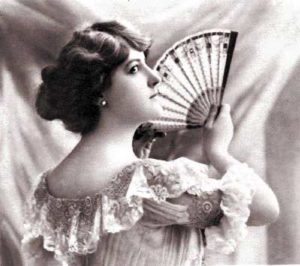 “Horses sweat. Men perspire. But ladies merely glow.” Have you ever heard that euphemism? I grew up with this saying but my mother’s version ended with “ladies get dewy!” Products developed during the Arts & Crafts era gave us tools to fight an age old problem: humans produce odors.
“Horses sweat. Men perspire. But ladies merely glow.” Have you ever heard that euphemism? I grew up with this saying but my mother’s version ended with “ladies get dewy!” Products developed during the Arts & Crafts era gave us tools to fight an age old problem: humans produce odors.
Historical Sweating—and Perspiring and Glowing
Before the advent of deodorant, people generally battled their offensive smells by masking them with perfumes (a practice dating back to the ancient Egyptians, Romans and Greeks).
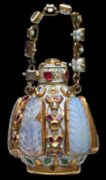
An ornate scent bottle from the 1500s. Worn my nobility, personal perfumes were necessary in a world where bathing and personal hygiene were not up to modern standards.
Body odor issues became worse before they improved, thanks to a belief in the Middle Ages in the evils of being naked, even in a bath. And submerging in water was considered a health risk. Perfumes were once again used by those who could afford them. Those without money remained less than fragrant.
 During the Victorian era, when cleanliness was emphasized, women bathed regularly and used special padding sewn into the armpits of their gowns to prevent odor and dampness from coming through. The padding was made from several layers of muslin with a thin cotton flannel in between. The flannel helped with absorption. Adding perfumes such as lavender or rose oil to the padding helped mask odors. At the time, body odor was not a concern for men because it was viewed as a sign of masculinity.
During the Victorian era, when cleanliness was emphasized, women bathed regularly and used special padding sewn into the armpits of their gowns to prevent odor and dampness from coming through. The padding was made from several layers of muslin with a thin cotton flannel in between. The flannel helped with absorption. Adding perfumes such as lavender or rose oil to the padding helped mask odors. At the time, body odor was not a concern for men because it was viewed as a sign of masculinity.
Mum Deodorant
Deodorant products work in one of two ways—by preventing sweat from occurring, or by allowing it to occur but preventing bacterial activity that creates an odor.
 In 1888, the first deodorant product for women was patented in the U.S. and marketed for sale. As the story goes, the inventor, possibly a doctor, asked his nurse to give the product a comforting name. Called “Mum,” the product was a zinc oxide-based cream that came in a small tin and was applied to the armpits using the fingertips. The cream was waxy; took a while to dry; and could leave a greasy residue on clothing.
In 1888, the first deodorant product for women was patented in the U.S. and marketed for sale. As the story goes, the inventor, possibly a doctor, asked his nurse to give the product a comforting name. Called “Mum,” the product was a zinc oxide-based cream that came in a small tin and was applied to the armpits using the fingertips. The cream was waxy; took a while to dry; and could leave a greasy residue on clothing.
Zinc oxide killed bacteria, effectively reducing odor in the armpits. Feminine scents such as rose and lilac were added to further cover body odor.
The Antiperspirants
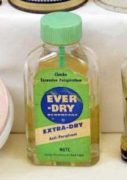 Deodorants can take care of smells, but they are not as effective at taking care of excessive sweating. The first antiperspirant, Everdry, was launched in 1903. It was an aluminum chloride solution that was applied with a cotton ball. It blocked pores to inhibit sweating. While it helped to avoid odor and prevent sweat stains on clothing, it could be irritating to the skin and eat through fabric.
Deodorants can take care of smells, but they are not as effective at taking care of excessive sweating. The first antiperspirant, Everdry, was launched in 1903. It was an aluminum chloride solution that was applied with a cotton ball. It blocked pores to inhibit sweating. While it helped to avoid odor and prevent sweat stains on clothing, it could be irritating to the skin and eat through fabric.
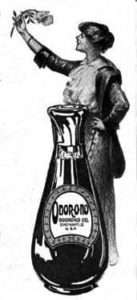
A graphic from an Odorono ad. The text states: “Odor-O-No is necessary to every dainty and economical woman. Dress shields afford doubtful protection, while Odor-O-No, the anti-dress shield toilet water, is a sure prevention.”
Next came an antiperspirant called Odorono (pronounced Odor-Oh-No), introduced at a 1912 summer exposition in Atlantic City. Although the product stopped sweat for up to three days—longer than other antiperspirants of the day—Odorono’s active ingredient, aluminum chloride, could, again, irritate sensitive armpit skin and damage clothing.
Slow to gain popularity, a well-planned marketing campaign made Odorono the best antiperspirant of the decade. Magazine and newspaper ads played on women’s insecurities. For example, one ad featured a “testimonial” by a young woman who overheard gossip. She was not popular with men because of her unfortunate underarm odor.
Another ad in a 1919 edition of the Ladies Home Journal had a headline of “Within the Curve of a Woman’s Arm, a frank discussion of a subject too often avoided.” The text went on to state: “A woman’s arm! Poets have sung of it, great artists have painted its beauty. It should be the daintiest, sweetest thing in the world. And yet, unfortunately, it isn’t always.” While some readers indignantly canceled their magazine subscriptions, the strategy worked and sales increased.
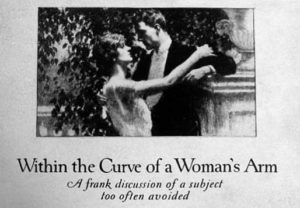
This photo and header set the stage for the full-page, text heavy Ladies Home Journal ad for Odorono.
And hoping to prevent the armpit skin irritation and damage to clothing, the ads advised women to avoid shaving prior to use and to swab the product into armpits before bed, allowing time to dry thoroughly.
Less irritating antiperspirants were developed in the 1930s—such as a cream-based product called Arrid Cream. The formulation for yet another product called Stopette was patented in 1941.
Mum Is the Word
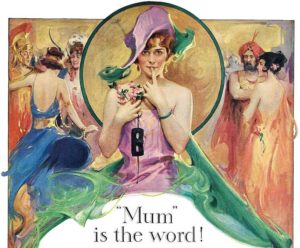
Beautiful graphic from a 1923 Mum deodorant ad. The ad touts “Mum takes all odor out of perspiration.”
Mum deodorant continued to be popular in the 1920s. Their ads also tapped into women’s concerns about popularity, gossip, attractiveness to men, and shame. Shaming women for chasing away potential husbands with their body odor was the most common tactic.
Ads promised women that deodorant would help them feel “at her daintiest and best.” Other more aggressive ads displayed headlines such as “Beautiful but dumb. She has never learned the first rule of lasting charm.”
And the product name played into the slogan “Mum is the word!” along with the image of a beautiful woman with her fingertip held to her lips as if to say “shush.”
What About Men?
The Great Depression put men’s status as the primary source of income at risk. Men were worried about losing a job or about the difficulties of finding one. For some, this challenged their masculinity.
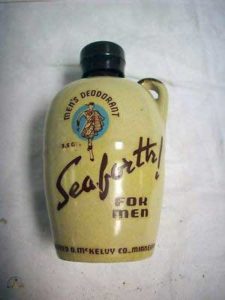 American deodorant companies had secured a female customer base, and they began focusing on men’s body odor. In 1935, Top-Flite became the first deodorant for men. Wanting to appear “manly,” it hit store shelves in a sleek, masculine black bottle, followed by other products such as Seaforth deodorant, offered in a ceramic whiskey jug.
American deodorant companies had secured a female customer base, and they began focusing on men’s body odor. In 1935, Top-Flite became the first deodorant for men. Wanting to appear “manly,” it hit store shelves in a sleek, masculine black bottle, followed by other products such as Seaforth deodorant, offered in a ceramic whiskey jug.
Advertisements for men’s deodorant products often focused on financial insecurities, suggesting “unprofessional grooming” (body odors) might ruin a man’s career. Anti-sweat products became a part of the daily grooming routine for both men and women.
As more companies invested in technology, the decades between 1940 and 1970 saw the development of safer product formulations as well as new packaging, such as sticks; roll-ons (based on the ballpoint pen); sprays; and aerosols.

A graphic and header from a 1915 ad for Odorono with the themes of “stopping troublesome perspiration in limited sections of the body like the armpits, feet, hand and neck” AND “keeping your gowns unstained, fresh and dainty.”
As we experience summer’s heat, never forget the message in an early ad for Mum: “A girl’s greatest asset is her personal daintiness!











